MR Safety
Traditional Poster
MRI Safety
Wednesday, 26 April 2017
| Exhibition Hall |
16:15 - 18:15 |
 |
2619. 
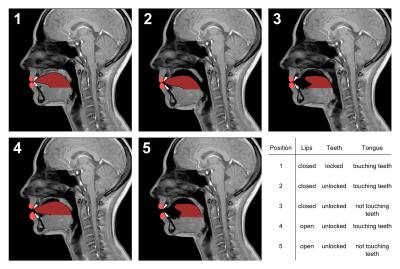 |
Metallic taste perception at 7 Tesla: Influences of jaw position and ionic composition of saliva
Wiebke Neumann, Andreas Bitz, Lothar Schad, Frank Zöllner, Mark Ladd, Armin Nagel, Jonathan Lommen
Up to 40% of subjects report metallic taste sensations when exposed to strong magnetic fields. Can the perception of metallic taste during an ultra-high field (UHF) examination be lessened and thus increase patient comfort? This study experimentally examines the influence of jaw position and ionic composition of saliva (salinity and acidity) on metallic taste perception. We found that simple changes in tongue and teeth positions as well as saline in the mouth decrease the metallic taste sensation during UHF exposure. Following the current trend to UHF applications, these findings allow for further insight regarding increased patient comfort and acceptance of UHF examinations.
|
|
2620. 
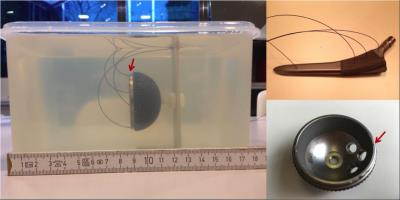 |
Gradient Heating of Bulk Metallic Implants
Rüdiger Brühl, Albrecht Ihlenfeld, Bernd Ittermann
The temperature increase of an excised hip prosthesis was measured under exposure to the switched gradients of a clinical 3T scanner. For the acetabular cup, insulated or embedded in gelatin gel, temperature increases of ΔT=25.8 K and 3.8 K, respectively, were observed within 10 min. From the initial temperature increase of up to 110 mK/s a gradient-induced heating power of PG = 370 W/kg in adjacent muscle can be derived and this quantity's relation to local SAR is discussed. The results suggest that gradient-induced heating of bulk metallic implants cannot automatically be assumed to be negligible.
|
|
2621. 
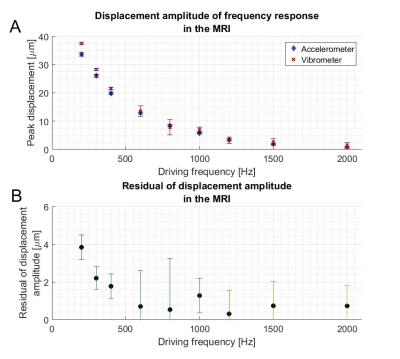 |
Comparison of Laser Doppler Vibrometer and Accelerometer Measurements of MRI Gradient Field Induced Vibration in Conductive Materials
Christine Tarapacki, Daniel Martire, Colin McCurdy, William Handler, Blaine Chronik
Measuring gradient field induced vibration is essential to determine the safety of medical devices in the MR environment. This study investigated vibrations measured both inside and outside the MRI to quantitatively compare the use of accelerometers and laser Doppler vibrometers in gradient field induced vibration testing. Measures were conducted as a function of frequency over the range applicable to MRI gradient coil operation. Results indicate measurements obtained with accelerometers are comparable with laser Doppler vibrometry.
|
|
2622.
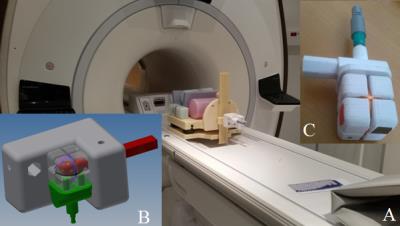 |
3D dB/dt measuring bench design and building for safety assessment
Pauline Ferry, Lucien Hammen, Rada Alnnasouri, Jacques Felblinger, Cédric Pasquier
In this project, the goal was to build a 3D dB/dt measuring bench to map in the MR scanner gradients fields components and to detect critical positions for safety assessment. Such positions are mandatory to assess gradients induced vibrations worst cases as described in the ISO TS 10974.
|
|
2623.
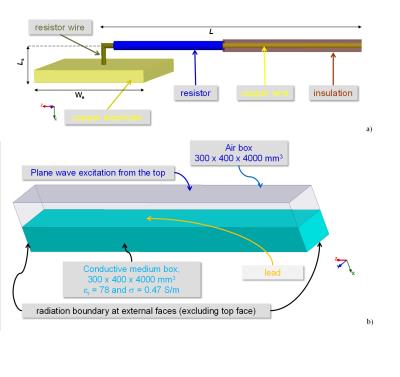 |
Applicability of lead electromagnetic model for an external wire with skin contact
Mikhail Kozlov, Nikolaus Weiskopf
We calculated the electromagnetic (EM) model of an external wire with an electrode that contacts human skin at 123.2 MHz and evaluated the influence of the electrode dimension as well as the distance between the wire and the human body on the EM model using an approximation of the human body by a single tissue flat phantom. Our case study provided a strong evidence that at 123.2 MHz there is no worst-case distance between a wire and a human body that maximizes the power deposition for any wire length or electrode width.
|
|
2624.
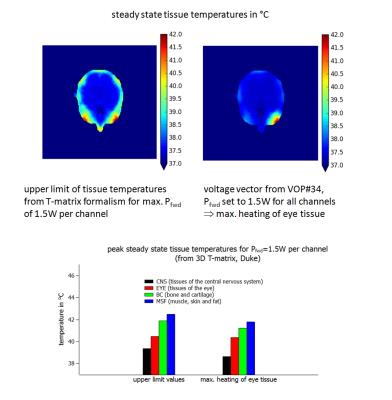 |
Evaluation of a thermal dose based safety concept for 7T pTx coils
Frank Seifert, Bernd Ittermann
We propose a straightforward procedure to calculate thermal dose values (CEM43) from upper limit values of tissue temperatures utilizing T-matrix formalism. The procedure is evaluated for a 7T 8-channel transmit/receive (pTx) head coil using the RF power data of a long duration neuroscience MR session and a scenario when heating of eye tissue is worst. The proposed approach, as a generalization of the thermal dose concept for body coils, is capable to determine reliably the risk of excessive tissue heating when using pTx coils.
|
|
2625. 
 |
Experimental and simulated distribution of the RF electrical field inside a birdcage coil
Isabelle Saniour, Gwenaël Gaborit, Lionel Duvillaret, Anne-Laure Perrier, Olivier Beuf
High-field MR systems bring additional safety issues regarding the patient. One of main concern is the heating effect caused by the high-frequency and high-power signals that can be picked up by the conductors. It is thus required to identify these regions and to quantify the electrical E-field knowing that it is proportional to the square of the temperature elevation. For a direct measurement, an optical probe was used to perform a mapping of the E-field distribution inside a birdcage of a preclinical MRI. Experiments and simulations were found similar with E-field concentrations mainly located close to the capacitors.
|
|
2626.
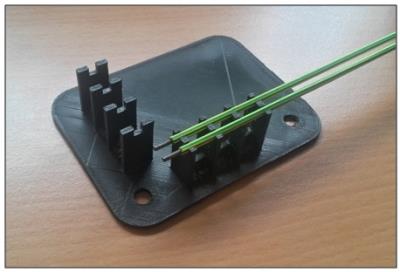 |
Quantification and impact of lead coupling on RF-induced heating in MRI.
Julie Kabil, Alexia Missoffe, Pierre-André Vuissoz, Cédric Pasquier, Jacques Felblinger
Patients carrying multiple leads like abandoned pacemaker leads are still denied MRI scans, as their situation is not currently covered by the existing safety guidelines. Therefore, to assess the impact of lead coupling regarding radiofrequency-induced heating, temperature measurements were performed on different types of simplified leads and coupling factors were introduced to quantify and evaluate the phenomenon. The lead coupling can have a significant impact on temperature and can either induce higher or lower temperatures compared to the case when the leads are alone, and thus should be considered in future MRI safety standards.
|
|
2627.
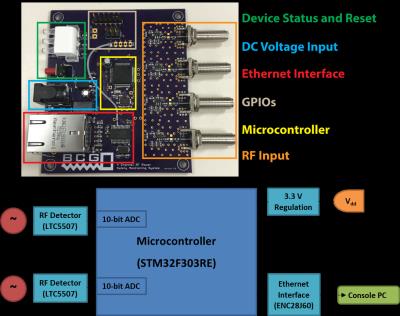 |
An Inexpensive, Modular, DSP-based SAR Monitor for Multichannel Transmit Systems
Adam Mehina, Brandon Albrecht, Karim Damji, Nicola De Zanche
We describe a modular power (SAR) monitor for multichannel systems whereby both the forward and reverse power of each channel are sampled and averaged on a dedicated board. Each board houses an inexpensive microcontroller with built-in ADCs for sampling the output of two power detectors. The microcontroller is programmed to perform time averaging, forward-reverse power subtraction and threshold detection. Multiple boards communicate simultaneously with a graphical user interface on a host computer.
|
|
2628.
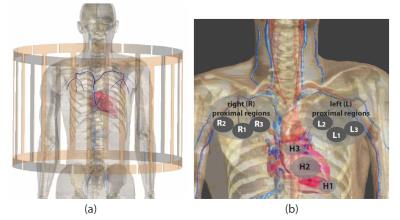 |
Test medium derivation for the safety assessment of RF-induced heating of leaded cardio implants during 1.5-T MRI
Aiping Yao, Earl Zastrow, Niels Kuster
It is a common practice that an equivalent mathematical model of an implant is used to estimate in vivo power deposition caused by RF-implant interactions. The model is often derived under in vitro conditions. We assess the suitability of test media for RF-induced heating model derivation at 64 MHz. Based on simple generic leaded-implants, our preliminary analysis shows that the test medium specified in ASTM 2182 (εr = 78, σ = 0.47 S/m) may be appropriate for the safety assessment of leaded cardio implants with respect to RF-induced heating. Future analysis shall include implants with diverse topology and increased realism.
|
|
2629.
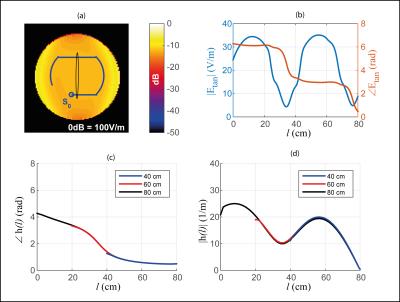 |
Test field diversification method for the safety assessment of RF-induced heating of AIMDs during 1.5-T MRI
Aiping Yao, Earl Zastrow, Niels Kuster
Elongated AIMD can pick up the RF-energy during MR exposure, and locally deposit the energy in the tissue near its vicinity --- typically near the conductive electrodes. Current experimental assessment strategy is capable to achieve only a limited set of AIMD exposure conditions. In this work, we outline a method by which the exposure conditions may be diversified during experimental testing. The feasibility of the method is evaluated for three generic implants. The RF-induced deposited power of the AIMD over more than 1000 exposure conditions was evaluated and approximately 20 dB dynamic range in the deposited power was achieved.
|
|
2630.
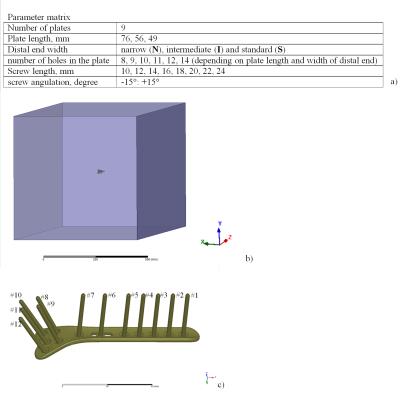 |
Investigation of RF-induced heating of distal radius implant system
Mikhail Kozlov, Gregor Schaefers
At 64 and 127.7 MHz RF-induced heating on or near nine distal radius implant systems was investigated. The 3-D temperature distribution after 15 minutes continuous excitation was obtained for a plane wave incident field. For one implant, random trials followed by a gradient-based investigation revealed three screw configurations that resulted in a high maximum temperature rise. Due to the smooth outcome of random trials followed by a gradient analysis, even relatively small simulation numbers allowed to reveal the configuration with the highest temperature rise for a given incident electrical field.
|
|
2631.
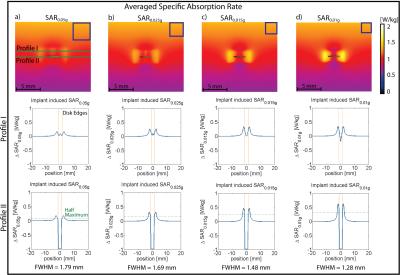 |
Smaller is better: Averaging mass considerations for the assessment of RF power deposition and MR safety of small implants
Eva Oberacker, Celal Oezerdem, Lukas Winter, Thoralf Niendorf
Assessment of the specific absorption rate (SAR) is a crucial tool when investigating the MR safety of implants. For RF power deposition assessments, local SAR averaged over m=10g of tissue is standard. Given the density in the human body (ρ≈1g/cm³), this translates into a volume of ≈2x2x2cm³, which largely exceeds the size of many small implants and bears the risk of heavy underestimation of local peak SAR. Realizing these constraints together with the opportunities, we investigated discrete SAR averaging masses from mave=1g to mave=0.01g to define SAR averaging masses suitable for the safety assessment of small implants.
|
|
2632. 
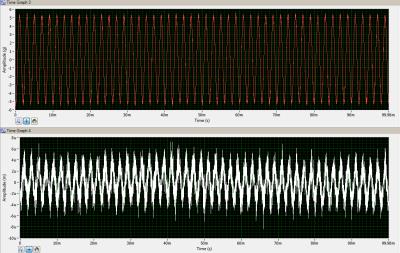 |
Characterization of gradient-induced vibration: Can optical displacement sensors be replaced by miniature accelerometers?
Amin Douiri, Stefan Scholz, Wolfgang Görtz, Jakob Kreutner, Gregor Schaefers
In this study the suitability of a miniature accelerometer for vibration measurements according to ISO/TS 10974 was investigated. Gradient-induced vibration of a titanium disc was measured both with an electric accelerometer and an optical displacement sensor and the obtained datasets were compared. Taking the characteristics of the setup into account, the results indicate that the used type of accelerometer is suitable to meet the specifications given in ISO/TS 10974.
|
|
2633.
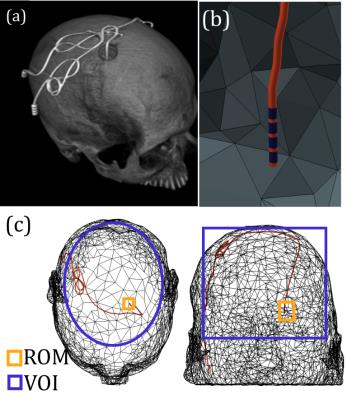 |
Parallel Transmission for Heating Reduction in Realistic Deep Brain Stimulation Lead Trajectories
Clare McElcheran, Laleh Golestanirad, Maria Iacono, Benson Yang, Kevan Anderson, Giorgio Bonmassar, Simon Graham
Implanted devices for deep brain stimulation (DBS) create a safety concern during MRI due to heating at exposed tip of the lead. Parallel transmit (pTx) can potentially reduce heating of the lead tip when radiofrequency (RF) inputs are selected by an appropriate numerical optimization method. To date, however, this method has not considered how the trajectory of DBS leads affects heat deposition. The present work investigates the optimized pTx method for realistic DBS lead trajectories estimated from intra-operative computed tomography (CT) scans of nine patients, with simulations indicating statistically significant reduction in heating at lead tips while maintaining reasonable B1+-field homogeneity.
|
|
2634.
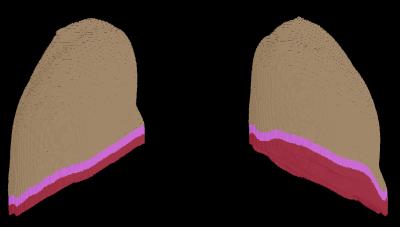 |
Bilateral Breast Phantoms for Fusion to Human Voxel Models for Specific Absorption Rate (SAR) Simulations
Xin Li, Xianglun Mao, Thomas Talavage, Joseph Rispoli
To comply with US Food and Drug Administration (FDA) guidelines of MRI safety, we propose a method to simulate Specific Absorption Rate (SAR) information with bilateral breast phantoms seamlessly integrated to a human model. This modeling method can be used with various breast phantoms. The simulation results indicate breasts with high glandular contents are more susceptible to SAR safety concerns compared to breasts with low glandular content.
|
|
2635. 
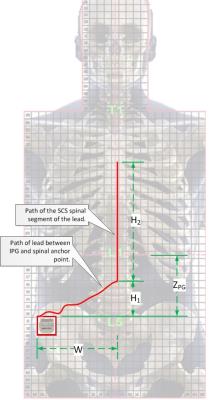 |
Attenuation of RF-induced currents within neuro-stimulation leads using a helical conductor design
Scott Kalpin, Norbert Kaula, Ramez Shehada
RF currents will be induced within implanted neuro-stimulation leads when exposed to Magnetic Resonance Imaging (MRI) fields. Induced currents result in dissipative heating that manifests at the electrode/patient contact points. The ideal lead design will attenuate induced 64-MHz RF energy coming from the MRI while passing signals in the lower, intended neuro-stimulation frequency range. A Nuvectra™ SCS lead, having a helical conductor coiling design, is evaluated. Results of MRI phantom experiments demonstrate RF-induced power attenuation between -6.2 and -12.5 dB/meter when exposed to combined fields from 1.5 Tesla, 2.77 W/kg for minutes.
|
|
2636. 
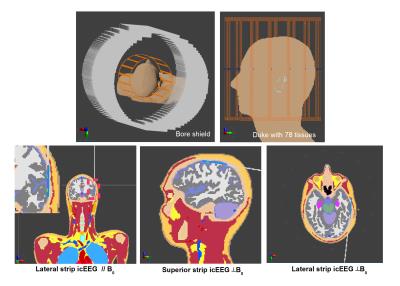 |
Safety of intracranial EEG recordings at 1.5T MR: electromagnetic field simulation on a human body model
Özlem Ipek, Hassan Hawsawi, Joao Jorge, David W. Carmichael, Louis Lemieux, Rolf Gruetter
Excessive tissue heating is one of the major concerns when performing MRI in patients with icEEG due to the RF interaction between the electrodes and head tissue. No electromagnetic field simulations has been performed on in-vivo iEEG-MR setup due to the subgridding limitations of the small dimensions of these electrodes relative to those of the human body. We showed the feasibility of full body EM-field simulations based on realistic icEEG-electrode design. The proposed FDTD method for simultaneous icEEG-MRI gives results that are in broad agreement with previous experimental observations while allowing for measurements of SAR/heating along the entire implant length.
|
|
2637. 
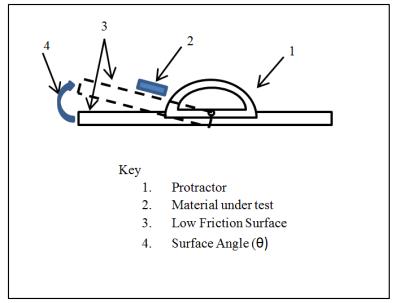 |
Magnetically Induced Torque Assessment per ASTM F2213 of Active Implantable Medical Device Lead Materials
Michael Childers, Shiloh Sison
This abstract presents magnetically induced torque measurements (per ASTM F2213) of materials commonly used in implantable leads. Implantable leads which are constructed solely from tested materials which pass the magnetically induced torque testing acceptance criteria of gravity torque, may not require magnetically induced torque testing per ASTM F2213 for MR conditionality with 3 T MR scanners.
|
|
2638. 
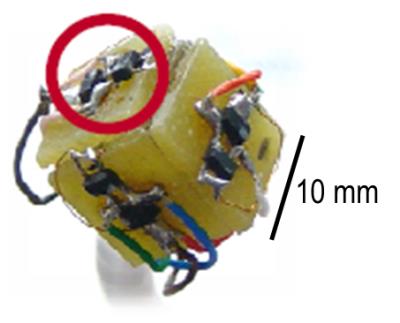 |
A Raspberry Pi® Based Portable Exposure Monitoring System for Magnetic Fields up to 7T.
Jens Groebner, Lukas Huber, Claus-Christian Glueer, Rainer Herges
ICNIRP recommends reference values for movements in magnetic fringe fields of MRI systems. Several probes have been presented using custom interfaces to record data. To open this field of research to a wider public a Raspberry Pi® based magnetic field monitoring system was built. A probe consisting of both three Hall sensors and induction coils was used. All channels were converted into frequency via voltage-to-frequency-converters. Data was stored internally via python. Measurements were performed on a 7T small-animal MRI at the hand of MR-workers. Reference values were exceeded at the hand. No transient effects like vertigo or nausea were noticed.
|
|
2639.
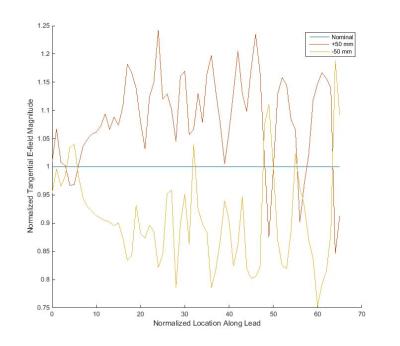 |
Evaluation of 50mm vs. 100mm Landmark Step Size for Pacemaker RF MRI Safety Evaluation
Lillian Boodaghians, Xin Huang, Xi Chen, Shiloh Sison
Pacemakers undergo evaluation per ISO/TS 10974 to determine MRI safety. In a 64 MHz 1.5T RF coil, a quarter wavelength for RF radiation within blood is approximately 130mm, suggesting simulations performed with z-dimensional landmark step size of 100mm might not sufficiently capture RF effects on power deposition at lead electrodes and voltage levels at the generator, requiring a 50mm step size instead. Through simulations using validated transfer functions, human body models, and MRI RF coil models, it is shown that the difference in results between 50mm and 100mm simulations may be incorporated into model uncertainty and 100mm simulations are sufficient.
|
|
2640. 
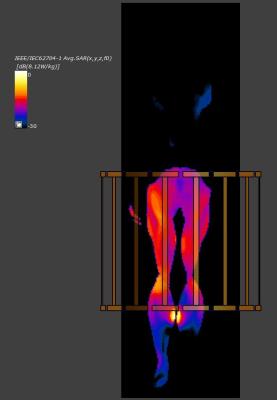 |
An investigation of skin/skin contact RF burns
Michael Steckner, Xin Chen
Third degree RF burns at skin/skin contact points have been reported. A thermal dose injury mechanism is widely assumed and thermal modeling results based on a well-documented calf burn report are presented. A hotspot ratio (Local:Whole Body SAR) of 86 results in various arbitrary CEM43 defined thresholds being exceeded after a few minutes of inadvertent skin/skin contact. The results support the hypothesis that skin/skin contact thermal injury burns are possible after several minutes of routine clinical scanning.
|
|
2641.
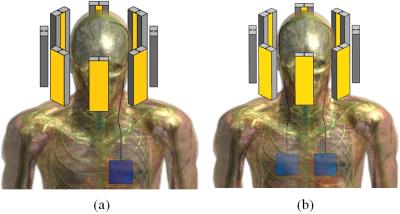 |
A Method to Reduce Specific Absorption Rate for DBS Patients at 7 T MRI
Eunbi Ye, Youngdae Cho, Rupam Das, Hyun-Man Baek, Hyoungsuk Yoo
The improtance of ultrahigh fields MRI has been rapidly increased due to its advantages in high resolution and signal-to-ratio. In this study, the SAR was analyzed in accordance with the conditions of insertion DBS and the electromagnetic field is controlled by multi-channel coil. Our reserch demonstrated the field control method using convex optimization from the fields data can be considered as a good strategy to drive the individual parameters of the RF coil for solving the inhomogeneity and SAR limitations, and it is safer for patients.
|
|
2642.
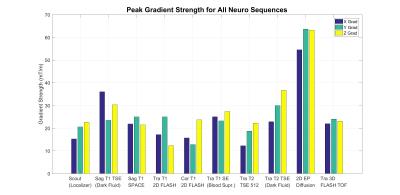 |
Clinically Relevant Gradient and RF Field Exposure Levels for General Neuro MRI Protocols at 3.0 T
Colin McCurdy, William Handler, Justin Peterson, Blaine Chronik
Maximum fields for MRI systems pose overly restrictive guidelines for MR compatible device development. Logging of gradient strengths on a Siemens Prisma 3T MRI showed that during clinically relevant neuro scans, peak gradient strength reached 63.97 ± 0.05 mT/m, lower than the system maximum of 80 mT/m. In addition, peak slew rate during this protocol was measured to be 183.9 ± 0.2 T/m/s, compared to the system maximum of 200 T/m/s. This allows more flexibility for MR compatible device manufacturers due to the large discrepancy between the system maximum, and the practical maximums that the system reaches.
|
|
2643. 
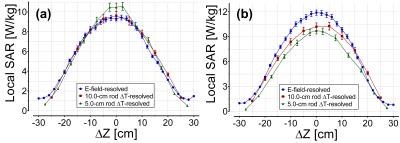 |
Resolving Local SAR In Vitro from RF-Field Induced Heating of a 5.0 cm Long Titanium Rod at 64 MHz and 128 MHz
Krzysztof Wawrzyn, John Drozd, Jack Hendriks, William Handler, Blaine Chronik
A methodology is developed relating the RF-induced temperature rise for an elongated conductive 5.0 cm long titanium reference rod to the local SAR produced by the incident electric field in the rods absence. Local SAR values at various spatial probing distributions in a gel filled phantom torso were systematically resolved and assessed at 64 MHz and 128 MHz using two different RF birdcage coils. A calibrated commercial E-field RMS probe and conventional standardized 10.0 cm long titanium rod were both used to validate the approach, showing good agreement. The 5.0 cm long rod shows promise as an additional approach for experimentally determining local SAR.
|
|
2644.
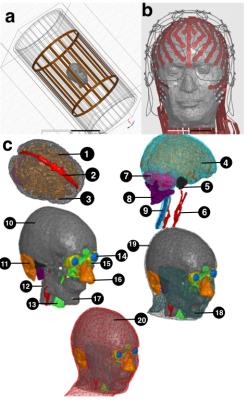 |
Numerical Simulation of Specific Absorption Rate (SAR) Induced in the Head as a Function of EEG Lead Conductivity during 256-channel dEEG/fMRI at 3T.
Seyed Reza Atefi, Peter Serano, Catherine Poulsen, Giorgio Bonmassar
This study presents the numerical quantification of the relationship between the EEG lead conductivity and SAR induced in the head in EEG-fMRI at 3T and using a 256-channel dense array sensor net. SAR induced in the head normalized by the gold standard of no sensor net was an S-curve function of the EEG lead conductivity in the range 1S/m - 5.8.107 S/m, plateauing at 1 for lead conductivities below 10 S/m.
|
|
2645.
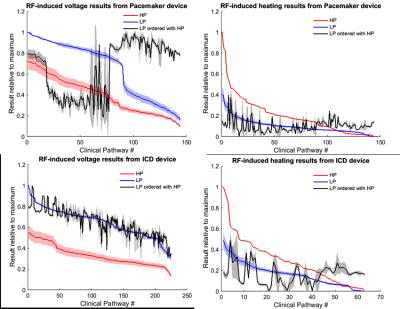 |
Comparison of High pass and Low pass Radio-Frequency coils in 1.5 T MRI safety assessments of Active Implantable Medical Devices
Hussain Fatakdawala, Xin Huang, Shiloh Sison
Active Implantable Medical Device (AIMD) safety assessments in MRI per ISO/TS 10974 may include computer simulations to evaluate radio-frequency (RF) induced heating of tissue and RF induced voltage at the device. It is not known if the differences in assessments between High-Pass (HP) and Low-Pass (LP) RF coils can be ignored. In this work, electric-fields and AIMD related RF induced heating and voltage results from HP and LP coils were compared. It was determined that there is a significant difference in safety assessment results between HP and LP coils (maximum symmetric mean absolute percentage error 50.21 ± 0.68%).
|
|
2646.
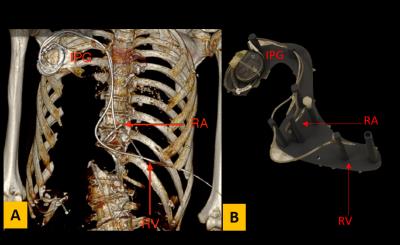 |
Comparison of Pacemaker Lead Tip Heating at 1.5 T and 3T
Jessica Martinez M, Volkan Acikel, Patrick Magrath, Daniel Ennis
Imaging patients with pacemakers at magnetic fields higher than 1.5T is widely contraindicated due to safety concerns. Since SAR increases with B0² it is expected that lead tip heating (LTH) may increase substantially. Recent studies, however, provide evidence that contradicts this belief. Electromagnetic damping can occur in highly conductive materials at high field strengths and may result in lower LTH. Our objective was to compare LTH at 1.5T and 3T for five pacemakers with realistic implant configuration in the ASTM torso phantom. The results obtained showed that heating at 3T was not greater than 1.5T, which supports the argument that electromagnetic damping can result in lower LTH at higher field strengths.
|
|
2647.
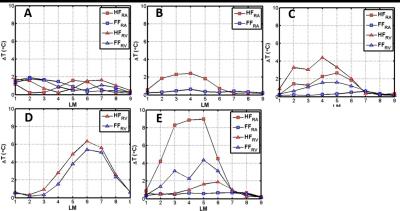 |
The Effect of Patient Orientation on Pacemaker Lead-Tip Heating at 1.5T
Jessica Martinez M, Volkan Acikel, Patrick Magrath, Daniel Ennis
Patients with pacemakers or implantable cardioverter defibrillators (ICDs) may require an MRI exam of any body part. Clinical guidelines indicate that patient orientation in the scanner depends only on the body part under examination. Lead tip heating (LTH) is also a function of patient orientation. In this study our objective was to compare LTH for head-first and feet-first orientations for five pacemakers with realistic implant configuration in the ASTM torso phantom. Our results suggest that depending on the anatomical region examined, proper patient orientation in the MRI scanner can reduce LTH.
|
|
2648. 
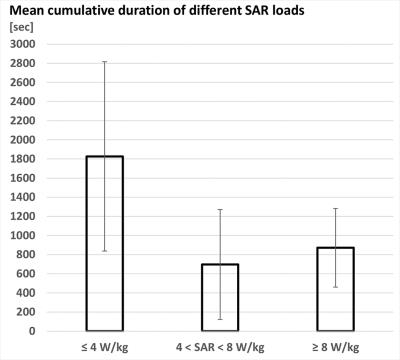 |
On the SAR load of typical head protocols at 7T
Oliver Kraff, Britta Hüning, Andreas Deistung, Viktor Pfaffenrot, Andreas Bitz, Mark Ladd, Harald Quick
In this retrospective study, log files of the RF safety watchdog system were evaluated from 30 head exams performed at 7T in conjunction with the widely available 32-channel Nova Medical head coil. Head local SAR as reported by the PALI and the start/end times of each sequence were compared for eight different sequence types. This study aimed at providing insights into the expected RF exposure in UHF neurological protocols and may become useful in simulations to study realistic exposure scenarios, as well as to determine which sequences may be acceptable if a SAR reduction is required for a 7T exam.
|
|
2649. 
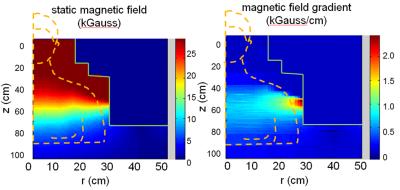 |
Static Magnetic Field (B0) Gradient Evaluation of a Compact 3T MR Scanner
Yunhong Shu, Shengzhen Tao, Mark Vermilyea, Thomas Foo, Paul Weavers, Joshua Trzasko, John III Huston, Matt Bernstein
The strength of the static magnetic field produced by a MR system varies with the distance from the scanner. This generates a magnetic field spatial gradient (SG) which produces an attractive translational force on ferromagnetic objects that approach the system. Because the SG has bearing on patient safety related to implanted medical device, it is essential to understand the field distribution of novel magnets, since each design has its own unique SG pattern. We performed on-site evaluation of the magnetic field SG for a novel high-performance compact 3T MR scanner to ensure patient safety during the subsequent clinical trial.
|
|
2650.
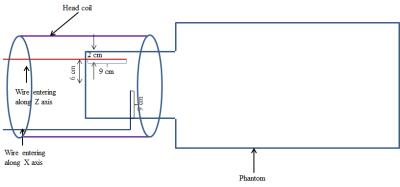 |
Dependence of RF-induced heating pattern during MRI of a single wire on its mode of entry in a dielectric medium
Pallab Bhattacharyya, Tanvir Baig, Bhumi Bhusal, Mark Lowe, Michael Martens, Stephen Jones
RF-induced heating of stereo encephalography (SEEG) electrodes during MRI scans could be of concern. Since the direction of entry of SEEG electrodes into brain can vary, heating of the tip of a single insulated copper wire (with bare tip) entering into a gel filled ASTM phantom axially (along the Z axis) and laterally (along the X axis) were measured as a function of the wire length. In this simple model of multi-wire multi-contact SEEG system, the resonating lengths (length with maximum heating) of the 2 configurations were same, while the lateral entry mode produced more heating.
|
|
2651. 
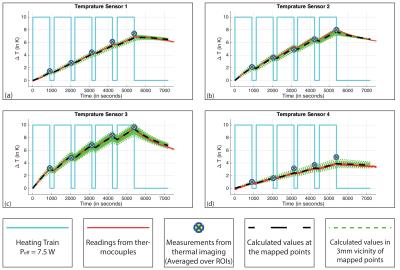 |
Validation of RF-induced temperature increase in a phantom: comparison of numerical simulations, MR thermometry and measurements from temperature sensors.
Shubham Gupta, R. Allen Waggoner, Keiji Tanaka, Kang Cheng
In this study, we compared the temperature increase calculated by the simulations and measured by the MR-thermometry in a phantom with those measured by the optical temperature sensors, with good agreement between the methods. To ensure safety, IEC guidelines require simulations of SAR along with validation in phantoms. While it is likely impossible to simulate every possible pulse shape and phase combination in a pTx system with a large number of transmit channels, the results we present here suggest that simulations plus MR-thermometry could provide the verification currently lacking in pTx studies.
|
|
2652. 
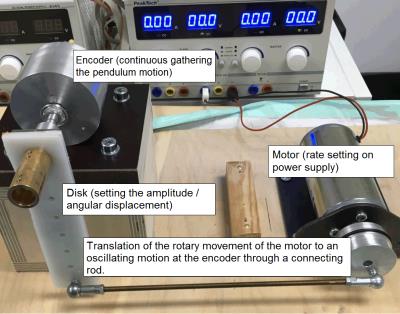 |
The encoder as leading part of detecting torque on implants for a fully automated test method in accordance to ASTM F 2213 standard to improve MR-Safety
Karina Schuller, Dominik Süß, Manuel Stich, Ralf Ringler
Due to magnetically induced torque, strong magnetic fields cause different effects on medical devices like implants. In accordance to that, this study should investigate by the help of a rotary encoder, if a rotary movement can be acquired to the ASTM standard. The used rotary encoder is specified with a high angular resolution, which enables detailed rotating motion detection, and its MR compatibility.
|
|
2653. 
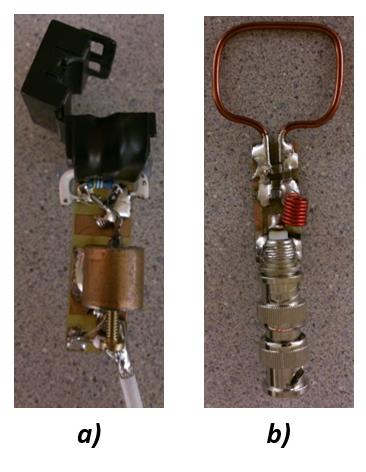 |
A Dedicated Measurement Probe for Quantitative Common Mode Measurements and Balun Efficiency.
Wolfgang Loew, Randy Giaquinto, Charles Dumoulin
A method to measure common mode voltages and balun efficiency is described. Common mode voltages were measured with a novel common mode measurement probe and oscilloscope along a coaxial cable of a loaded loop coil which was excited with a network analyzer at 127.74MHz. The common mode measurements were performed on the loop coil without a balun and compared to the same loop coil with a balun to evaluate the common mode attenuation of the balun.
|
|




































